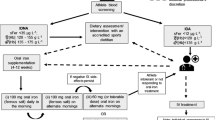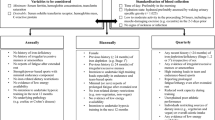Abstract
There is still debate in the literature on whether or not endurance athletes tend to have low iron stores. In this article, we propose that endurance athletes really are at risk of becoming iron deficient due to an imbalance between absorption of dietary iron and exercise-induced iron loss. The purpose of this article is to present a critical review of the literature on iron supplementation in sport. The effect of iron deficiency on performance, its diagnosis and suggestions for treatment are also discussed.
Studies of the nutritional status of athletes in various disciplines have shown that male, but not female, athletes clearly achieve the recommended dietary intake of iron (10 to 15 mg/day). This reflects the situation in the general population, with menstruating women being the main risk group for mild iron deficiency, even in developed countries. Whereas the benefit of iron supplementation in athletes with iron deficiency anaemia is well established, this is apparently not true for non-anaemic athletes who have exhausted iron stores alone (prelatent iron deficiency); most of the studies in the literature show no significant changes due to supplementation in the physical capacity of athletes with prelatent iron deficiency. However, the treatment protocols used in some of these studies do not meet the general recommendations for the optimal clinical management of iron deficiency, that is, with respect to adequate daily dosage, mode of administration and treatment period. For future studies, we recommend a prolonged treatment period (≥3 months) with standardised conditions of administration (use of a pharmaceutical iron preparation with known high bioavailability and a dosage of ferrous (Fe++) iron 100 mg/day, taken on an empty stomach).
Currently, decisions regarding iron supplementation are best made on the basis of taking care of individual athletes. We believe that there are sufficient arguments to support controlled iron supplementation in all athletes with low serum ferritin levels. Firstly, the development of iron deficiency is prevented. Secondly, the nonspecific upregulation of intestinal metal ion absorption is reverted to normal, thus limiting the hyperabsorption of potentially toxic lead and cadmium even in individuals with mild iron deficiency.
Similar content being viewed by others
References
Balaban EP. Sports anemia. Clin Sports Med 1992; 11 (2): 313–25
Weight LM, Klein M, Noakes TD, et al. Sports anemia: a real or apparent phenomenon in endurance-trained athletes?. Int J Sports Med 1992; 13: 344–7
Newhouse IJ, Clement DB. Iron status in athletes: an update. Sports Med 1988; 5: 337–52
Haymes EM, Lamanca JL. Iron loss in runners during exercise: implications and recommendations. Sports Med 1989; 7: 277–85
Smith JA. Exercise, training and red blood cell turnover. Sports Med 1995; 19 (1): 9–31
Burke LM, Read RSD. Dietary supplements in sport. Sports Med 1993; 15: 43–65
Fogelholm M. Indicators of vitamin and mineral status in athletes blood: a review. Int J Sport Nutr 1995; 5: 267–84
Baynes RD. Iron deficiency. In. Brock JH, Halliday JW, Pippard MJ, et al., editors. Iron metabolism in health and disease. London: Saunders, 1994; 189–226
Heinrich HC. Intestinal iron absorption in man: methods of measurements, dose relationship, diagnostic and therapeutic applications. In. Hallberg L, Harwerth HG, Vannotti A, editors. Iron deficiency. London/New York: Academic Press, 1970: 213–94
Heinrich HC. Falsely low normal values for serum ferritin?. Clin Chem 1981; 27: 768
Nachtigall D, Nielsen P, Fischer R, et al. Iron deficiency in distance runners: a reinvestigation using 59Fe-labelling and non-invasive liver iron quantification. Int J Sports Med 1996; 17: 473–9
Ehn L, Carlmark B, Höglund S. Iron status in athletes involved in intense physical activity. Med Sci Sports Exerc 1980; 12 (1): 61–4
Magnusson B, Hallberg L, Rossander L, et al. Iron metabolism and sports anemia. Acta Med Scand 1984; 216: 157–64
Pattini A, Schena F. Effects of training and iron supplementation on iron status of cross-country skiers. J Sports Med Phys Fitness 1990; 30 (4): 347–53
Herbert V. Recommended dietary intakes (RDI) of iron in humans. Am J Clin Nutr 1987; 45: 679–86
van Erp-Baart AMJ, Saris WMH, Binkhorst RA, et al. Nationwide survey on nutritional habits in elite athletes: part II: mineral and vitamin intake. Int J Sports Med 1989; 10 Suppl. 1: S11–6
Weight LM, Jacobs P, Noakes TD. Dietary iron deficiency and sports anemia. Br J Nutr 1992; 68: 253–60
Nuviala RJ, Castillo MC, Lapieza MG, et al. Iron nutritional status in female karatekas, handball and basketball players, and runners. Physiol Behav 1996; 59 (3): 449–53
Lyle RM, Weaver CM, Sedlock DA, et al. Iron status in exercising women: the effect of oral iron therapy vs increased consumption of muscle foods. Am J Clin Nutr 1992; 56: 1049–55
Rowland TW, Deisroth MB, Green GM, et al. The effect of iron therapy on the exercise capacity of nonanemic iron-deficient adolescent runners. Am J Dis Child 1988; 142: 165–9
Magazanik A, Weinstein Y, Abarbanel J, et al. Effect of an iron supplement on body iron status and aerobic capacity of young training women. Eur J Appl Physiol 1991; 62: 317–23
LaManca JJ, Haymes EM. Effects of iron repletion on VO2max, endurance, and blood lactate in women. Med Sci Sports Exerc 1993; 25: 1386–92
Risser WL, Lee EJ, Poindexter HBW, et al. Iron deficiency in female athletes: its prevalence and impact on performance. Med Sci Sports Exerc 1988; 20: 116–21
Powell PD, Tucker A. Iron supplementation and running performance in female cross-country runners. Int J Sports Med 1991; 12: 462–7
Fogelholm M, Jaakkola L, Lampisjaervi T. Effects of iron supplementation in female athletes with low serum ferritin concentration. Int J Sports Med 1992; 13: 158–62
Klingshirn LA, Pate RR, Bourque SP, et al. Effect of iron supplementation on endurance capacity in iron-depleted female runners. Med Sci Sports Exerc 1992; 24: 819–24
Dressendorfer RH, Keen CL, Wade CE, et al. Development of runner’s anemia during a 20-day road race: effect of iron supplements. Int J Sports Med 1991; 12: 332–6
Newhouse IJ, Clement DB, Taunton JE, et al. The effects of prelatent/latent iron deficiency on physical work capacity. Med Sci Sports Exerc 1989; 21: 263–8
Karamizrak SO, Islegen C, Varol SR, et al. Evaluation of iron metabolism indices and their relation with physical work capacity in athletes. Br J Sports Med 1996; 30: 15–9
Matter M, Stittfall T, Graves J, et al. The effect of iron and folate therapy on maximal exercise performance in female marathon runners with iron and folate deficiency. Clin Sci 1987; 72: 415–22
Gardner GW, Edgerton VR, Barnard RJ, et al. Cardiorespiratory, hematological and physical performance responses of anemic subjects to iron treatment. Am J Clin Nutr 1975; 28: 982–8
Schoene RB, Escourrou P, Robertson HT, et al. Iron repletion decreases maximal excercise lactate concentrations in female athletes with minimal iron-deficiency anemia. J Lab Clin Med 1983; 102: 306–12
Walters GO, Miller FM, Woorwood M. Serum ferritin concentration and iron stores in normal subjects. J Clin Pathol 1973; 26: 770–2
Nielsen P, Gabbe EE, Fischer R, et al. Bioavailability of iron from oral ferric polymaltose in humans. Arzneimittel Forschung 1994; 44: 743–8
Heinrich HC, Gabbe EE, Kugler G, et al. Iron absorption from ingested pork, hog-liver and haemoglobin in subjects with normal and depleted iron stores: studies on dietary prophylaxis and therapy. Klin Wochenschr 1971; 49: 819–25
Sölvell L. Oral iron therapy — side effects. In. Hallberg L, Harwerth HG, Vannotti A, editors. Iron deficiency. London/New York: Academic Press, 1970: 573–83
Hooper SL, Mackinnon LT. Monitoring overtraining in athletes: recommendations. Sports Med 1995; 20 (5): 321–7
Dressendorfer RH, Wade CE, Amsterdam EA. Development of pseudoanemia in marathon runners during a 20-day road race. JAMA 1981; 246: 1215–8
Magnusson B, Björn-Rasmussen E, Hallberg L, et al. Iron absorption in relation to iron status: model proposed to express results to food iron absorption measurements. Scand J Haematol 1981; 27: 201–8
Watson WS, Morrison J, Bethel MI. Food iron and lead absorption in humans. Am J Clin Nutr 1986; 44: 248–56
Salonen JT, Nyyssnen K, Korpela H, et al. High stored iron levels are associated with excess risk of myocardial infarction in eastern Finnish men. Circulation 1992; 86: 803–11
Stevens RG, Jones DY, Micozzi MS, et al. Body iron stores and the risk of cancer. N Engl J Med 1988; 319: 1047–52
Baer DM, Tekawa IS, Hurley LB. Iron stores are not associated with acute myocardial infarction. Circulation 1994; 89: 2915–8
Niederau C, Fischer R, Sonnenberg A, et al. Survival and causes of death in cirrhotic and non-cirrhotic patients with primary hemochromatosis. N Engl J Med 1986; 313: 1256–62
Feder JN, Gnirke A, Thomas W, et al. A novel MHC class I-like gene is mutated in patients with hereditary haemochromatosis. Nature Genet 1996; 13: 399–408
Author information
Authors and Affiliations
Corresponding author
Rights and permissions
About this article
Cite this article
Nielsen, P., Nachtigall, D. Iron Supplementation in Athletes. Sports Med 26, 207–216 (1998). https://doi.org/10.2165/00007256-199826040-00001
Published:
Issue Date:
DOI: https://doi.org/10.2165/00007256-199826040-00001




